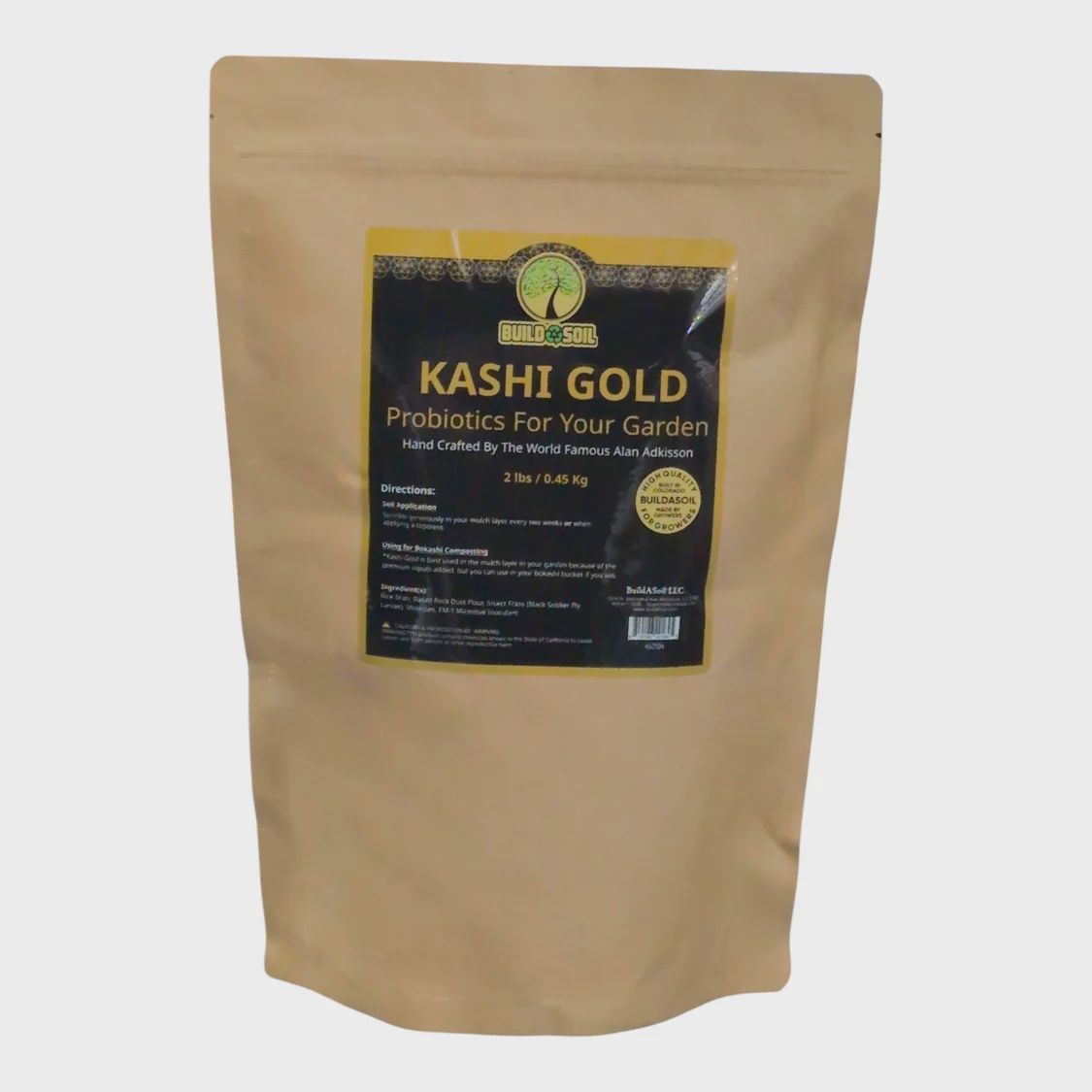BuildASoil Kashi Gold - 2lb Bag
BuildASoil Kashi Gold
Description
Your mulch isn’t breaking down fast enough, nutrients feel “locked up,” and you want that living-soil pop without overcomplicating things?
Kashi Gold is our answer: an artful, small-batch bokashi designed specifically for gardening, not just composting. Sprinkled on the mulch layer, it teams up with your soil food web so plants can intelligently access nutrients through thriving soil food web networks.
The Story Behind Kashi Gold
Deep Roots, Refined Craft
Bokashi is ancient anaerobic fermentation. Years ago, through the Probiotic Farmers Alliance, we met Alan Adkisson, the first person we knew to design a complete bokashi for growing plants. This business was founded with his partner Eddy Lepp. His approach (what he called solid-state fermentation) delivered visible white, pillowy mycelial growth on mulch and faster breakdown in living beds.
Alan launched Gro-Kashi, which set the bar. Later, a past employee of BuildASoil named AJ built on that legacy with Kashi Blend at Growing Organic. When that chapter closed, we came full circle: Alan rejoined us. Together, we set out to make the best bokashi for gardens, treated like a premium culinary experience for your soil from start to finish.
What’s Inside (and Why It Matters)
- Premium High Phos Rice Bran
- EM-1 (Dr. Higa’s original) to drive consistent, proven fermentation.
- Good Vibes Paramagnetic Basalt rock dust flour for coenzymes and trace mineral synergy along with paramagnetic energy.
- Insect frass as an additional food source for the biology
- Small percentage of Redmond sea salt to round out the fermentation ecology.
- Organic cane sugar molasses (never the cheap stuff) to feed the process.
How It’s Crafted
Fermented, dried, and finished with care by Alan, whose process has been refined over years of hands-on work. He includes sun activation to encourage PNSB activity and preserve the living character you’ll notice the moment you open the bag an ancestral, sour-fermented aroma growers love. ☀️
What You’ll Notice In Living Soil
- Faster mulch breakdown and visible white bacterial growth.
- Improved nutrient cycling right in the mulch layer.
- Smoother plant access to minerals without juggling extra bottles.
Instructions for Use:
- Top-dress: Sprinkle 2–4 tbsp per sq ft across the mulch layer every 1–3 weeks.
- For new beds or heavy mulch: use handfuls tossed in to kickstart activity.
- Water in lightly to activate fermentation on the surface.
- Compost boost (optional): Mix ½–1 cup per cubic foot of compost.
- Storage: Keep sealed, cool, and dry to preserve viability. Solid state fermentations can last for years.
- NOTICE: Animals will be wildly attracted to your bag of Kashi Gold. Store somewhere safe or your pets and or mice will find it and eat it all.
Quick Notes
- Pairs perfectly with living mulches, compost top-dress, and BuildASoil amendments.
- Use year-round in no-till and organic systems, indoor or outdoor.
- Aroma is excellent and inviting: that tangy, fermented scent signals quality.
If you’ve followed our journey from Gro-Kashi to Kashi Blend and back with Alan, you’ll recognize the intent: honor tradition, refine the craft, and deliver garden-ready bokashi that simply works.
Mycelium?
We all called it this in the beginning, but eventually the community has realized that this is likely a bacteria called actinomycetes
Actinomycetes (Streptomyces species):
These bacteria behave like fungi and create the white, cobweb-like filaments you’re seeing. They play a major role in breaking down tough plant materials such as cellulose, lignin, and chitin. Actinomycetes also produce antimicrobial compounds, which help suppress pathogens.

